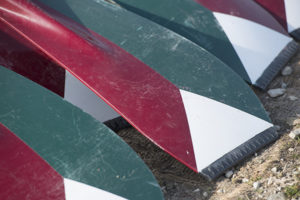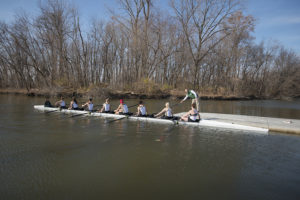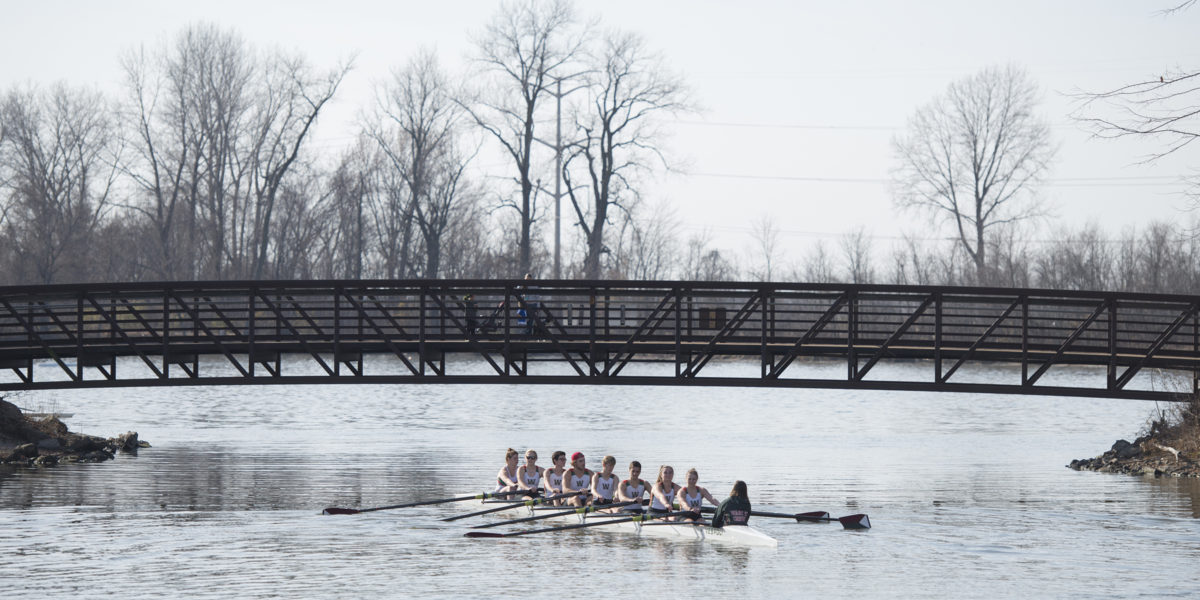At 5 a.m., that magic hour when darkness begins its melt into possibility, not much is stirring on the Washington University in St. Louis campus — unless you happen to be its chancellor, famous early-riser Mark Wrighton, or one of the 40 men and women athletes of the Washington University Crew team.
That’s the time a bus and maybe a few cars leave the Danforth Campus and make the 16-mile trip to Creve Coeur Lake in west St. Louis County. By 5:30 a.m., the team is on the lake for two hours of rowing, sweat and pain, arguably the hardest workout of any athlete on campus.

By 8:15 a.m., a time most students call “early,” they’re back on campus eating breakfast. By 9 a.m., most of them begin their academic day. By 4 p.m., they’re at it again, with weight training and conditioning. It’s time management on speed, a discipline both necessary and inescapable. And to a person on the crew team, one of the university’s 40-plus club sports, they love it.
“Not going to lie: rowing hurts,” said Chris Gohlke, a senior in the School of Engineering & Applied Science and a coxswain on the men’s team. “But to get up and go to practice every morning, that’s something. Rowing builds you up physically and mentally. It sticks with you your whole life. It’s discipline that goes beyond the boat.”
It’s that “beyond the boat” part that makes rowing at Washington University worthwhile.
“When you’re waking up early, on a sleep pattern that is so different from your classmates, you bond over that,” said Catherine Tiffany, a junior anthropology major in Arts & Sciences who was named last spring an All-American by the American Collegiate Rowing Association. “It’s hard not to get close to your teammates.”
“It’s a group of people who want to see you succeed not only in rowing but in the classroom,” said Chase Antonacci, team president and a junior philosophy-neuroscience-psychology major in Arts & Sciences. “It’s a unique positive, supportive environment — even though rowing is super challenging. It’s the reason people stick with it.”
And they’re sticking with a team on the rise, a team ready to build on the success of this past fall and break out on the national scene. And it all starts at 5:30 a.m., on a lake 16 miles from campus, with the sun rising and morning calling.
“The commitment of our athletes is the biggest story we have,” said Andrew Black, who is in his second season as head coach after seven years as varsity boys coach for the St. Louis Rowing Club, the entity with which Washington University Crew shares the boathouse at the 320-acre Creve Coeur Lake. “They practice six days a week, outside of academics, on their own time. They’re phenomenal.”
Black, a native of England and a rower since high school, is determined to build a national rowing program at Washington University and is working to find the right athletes, students who may or may not have rowing experience, but have the drive and determination to put in the kind of work it takes to gain national prominence.
“People who succeed are the ones who are good at time management and who understand how to do it right,” Black said. “You get up in the morning and you do your rowing and then you have the rest of your day. I advise the students to schedule their classes in the morning as much as they can. That way, they get their rowing in, their classes are finished and then the day opens up for them to think about getting other projects done and,” he laughs, “any kind of social life they might have.”
A team on the rise
WashU Crew has been around since 1985, when, with the help of John Schael, then the athletic director, the team was started by graduate student Andy Laine with an assist from a Yale oarsman named Karl Heilman. From the beginning, the team wanted to build on the rowing culture that already existed here with the St. Louis Rowing Club and the facilities at Creve Coeur Lake, the site of rowing for the 1904 Olympic Games.
The team received international attention in 2015 after a school of Flying Asian carp interrupted a morning practice. But its members would much rather be known for winning races instead of flying fish.
It’s just more proof — as if any is needed — that the sport is not for the faint of heart, or legs. “You use your whole body: leg, trunk and arms,” Tiffany said. “But it’s more legs than arms, like 60 or 70 percent legs.”
Rowers race in boats of two, four and eight, each of which presents its own challenge. “The pair is most difficult for me,” Tiffany said, “in that you need to have equal pressure application, otherwise your timing is off and the boat will turn.
“When you get to the four, it’s tippier than the eight but a little more stable than two, and you’re moving faster,” Tiffany said. “And once you get to the eight, you’re moving really fast but the boat is stable. So you learn different ways to row each race. When the boat’s moving quicker, you put your oar in differently, and apply a little more power to maintain the speed.
“With rowing, you don’t have to be a natural athlete,” Tiffany said. “You don’t need the hand/eye coordination that you need to be successful in other sports. So you truly get out of it what you put into it.
“If you work hard, you will be successful,” she said.
All of which adds up to 40 team members, rowing daily and learning that good things come from practice, practice, practice. This past fall, the team achieved its biggest goal yet at a race in Boston, the Head of the Charles Regatta.
One of the most prestigious races of the year for any collegiate program, WashU Crew was participating as a lottery entry, racing 4-person boats in both men’s and women’s races. In order to get an automatic bid for next year, each team had to finish in the top 50 percent.
Mission accomplished. The men’s team finished 16th out of 40 entries; the women 18th out of the 36. “That race was special and gives us a lot of momentum,” Gohlke said. “It’s really great for the program that we were able to perform at the highest level of collegiate crew.”
What’s next
Creve Coeur Lake has, at the current time, more than a few inches of ice as is typical for the month of January. But winter training sessions (which start at the late hour of 6 a.m.) continue on the South Campus, where a new practice facility called the erg room (named for the rowing machines that provide offseason training) opened in 2016. “It’s about as good as anything our peers would have,” Black said.
Winter workouts are a bit low-key, if you can call anything in rowing low-key. “We work on strength and conditioning and give them targets to work toward,” Black said. “We keep an eye on their progress.”

In a few weeks, on Saturday, Feb. 3, the Clark-Fox Forum in Hillman Hall will become its own erg room, when the team hosts the St. Louis Indoor Rowing Championships, with qualified competitors eligible for the world indoor rowing championship in Alexandria, Va., later in the year.
After that, it’s back on the water for a session or two when the lake thaws in late February or early March, before the team heads to central Florida for its annual spring break training trip. There, they’ll row three times a day, to, as Black said, “really lubricate the joints so that when we get back, they’re ready for the daily routine.”
“Everyone’s really excited about the spring schedule,” Antonacci said. “We want to build on what we did this fall and work toward spring racing to hopefully do well at the national championships in May.”
But no matter what, any member of the team will say it’s not about the finish line. “You train all year and spend so much time for basically a race that lasts six or seven minutes,” Antonacci said. “You get to the middle of a race and it’s super painful — you’re feeling the burn in your legs. But then you realize how much work and time you’ve put into it, and you’ve got those people in your boat that you can’t let down for those six or seven minutes. So you keep rowing.”
And the team keeps practicing, in those early morning hours when most of us are sleeping. “With rowing, it’s a lot about rhythm,” Tiffany said. “Every once in awhile, when you’re out on the lake in the morning and and everyone’s getting their blade in the water at the right time, you can hear the water rushing past you on the boat. The birds are starting to sing, and the sun is coming up, and you think, ‘This is really cool!’ ”

